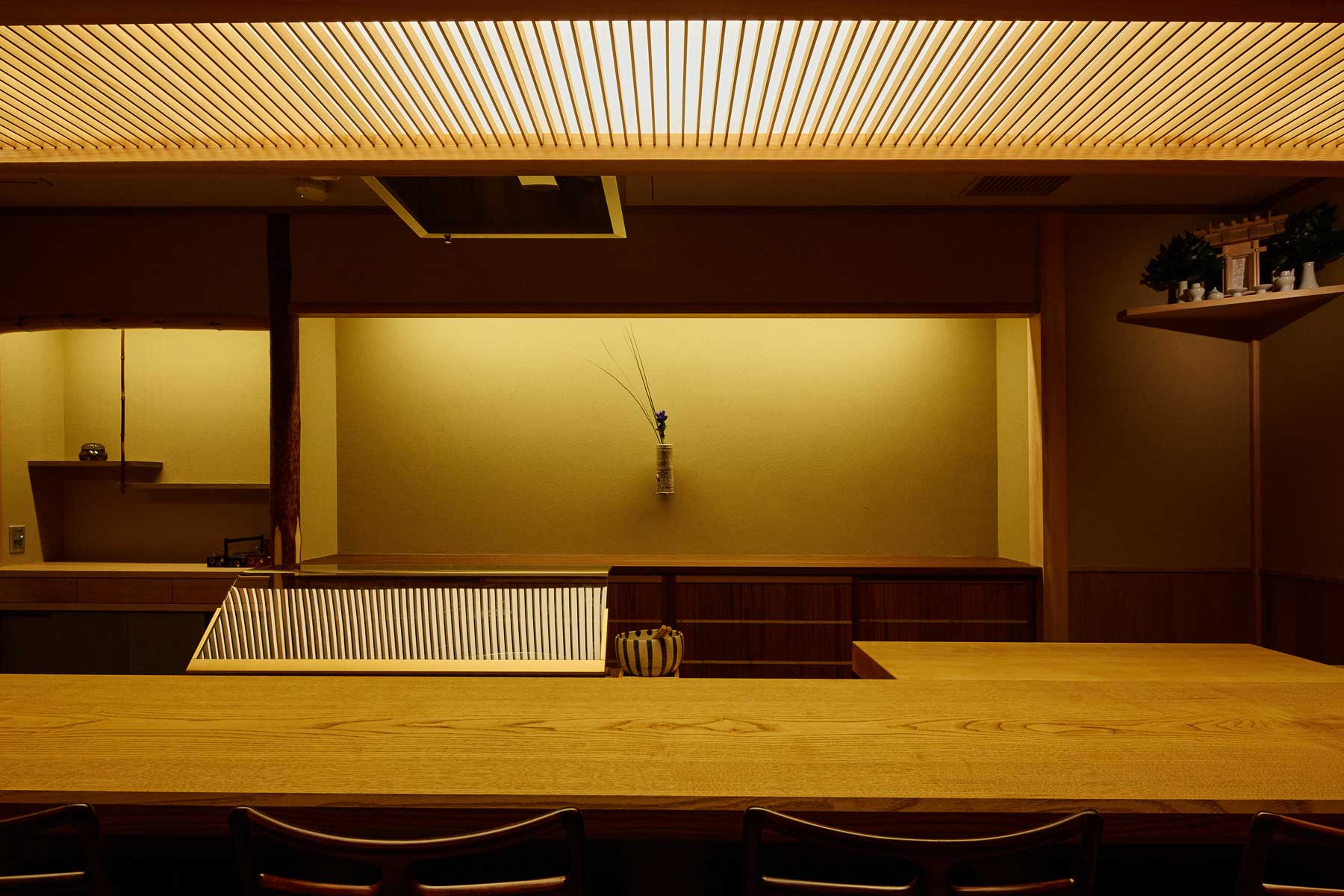
Tokyo
Tempura Niitome
天ぷら にい留
A peerless culinary destination has been born. Having revolutionized the art and coaxed guests from near and far with jaw-droppingly delicious tempura at its Nagoya restaurant, Tempura Niitome now embarks on a new chapter in the latest high-rise complex in the vast Tokyo metropolis. TABLEALL guests would be foolish to miss this exclusive invitation to savor premium ingredients fried to shockingly crisp perfection in a meticulous Japanese space with a friendly atmosphere created by a husband-and-wife team.
Let TABLEALL open the door to an exclusive dining experience with the ultimate in tempura. The chef of Tempura Niitome took the plunge and moved his highly acclaimed restaurant from Nagoya to Tokyo in the autumn of 2023. The new stage for his thrilling cuisine is Azabudai Hills, Tokyo’s latest skyscraper and commercial complex designed as a modern urban village. But only those personally invited by the chef can take a seat at this revered counter in a most unusual style in the culinary world. The only exception to this rule is TABLEALL guests.
The restaurant entrance is removed from the main commercial complex and is beside a staircase leading to Nishikubo Hachiman Shrine. Brimming with refined sophistication, the entrance is flanked by bamboo, and the stones underfoot were formerly at Windsor Castle. Such exquisite materials sourced by famed Kyoto architects Sankaku-ya are accented by Japanese touches like tsuji-andon garden lanterns often found at Kyoto inns. The calligraphy signboard features the brushstrokes of Keiko Maki, proprietor of Kyoto’s traditional Japanese tableware and crafts store Yobi. In devising a unique character combination to write tempura, Maki and the chef agreed on the kanji for “wind” for its connection to the wonderfully light and airy batter Niitome serves his guests.
The chance to start afresh means this space fully embodies Niitome’s philosophy. The chef insisted on top-notch materials, like sturdy and aromatic Japanese umbrella pine columns, no matter how painstaking the approval process was to meet the building’s strict construction standards. The resulting space exudes the traditional Japanese aesthetic and allows you to immerse yourself in that beauty. The focus is on the authentic in an age where priorities are often elsewhere. Even Niitome’s chef’s coat is an order-made original design that is simultaneously functional and handsome.
Beneath an internal timber roof is the entrance that adopts the traditional sukiya style found in teahouses. At the center, a draped noren curtain leads you into a waiting area for settling into the tranquility before proceeding through another entrance to the main dining area. It is a thoroughly private space dotted with Edo-period antiques that make you feel like you have stepped into a museum. In contrast are more modern antiques, like the reupholstered 1960s rosewood chairs lined up along the straight eight-seat counter. The beautiful single-plank chestnut timber diverges from the typical hinoki cypress of Japanese restaurants and is punctuated by the frying pot. Shielded only by a layer of glass, everyone can witness Niitome’s deft movements and be mesmerized by the gentle popping sounds in the oil pot. It is hard to hide your hunger with all this stimulation, but thankfully, it is never long before each dish is placed before you.
CUISINE
Revolutionizing tempura
Chef Niitome wants the flavors of his premium ingredients in light-as-a-feather batter to stay in your memory forever. With a course that begins with four to five appetizer dishes followed by around thirteen tempura morsels of seafood and vegetables, all your tempura preconceptions will be overturned, making for an unforgettable experience. During an intermission in which you are treated to a refreshing vinegared creation, the chef changes the oil in preparation for your closing dish – a choice of ten-don rice topped with tempura; tempura chazuke, like tendon but finished with umami-rich green tea poured over the top; or tenbara containing rice mixed with a broken-up fritter. With the light batter, perfect tempo, and fun conversation with the chef, you leave feeling fulfilled, but not in the least heavy, and thoroughly entertained.
Niitome has mastered the art of a batter so fine that it wows you with its texture without masking any of the produce’s innate flavors. Not only is his flour stored at almost freezing point, but Niitome makes the unconventional move of turning down or even turning off the oil midway through the frying process. He controls the flavors through minute temperature changes, driven by a creed of intervening just enough to enhance the ingredients’ flavors through frying.
In a summer course, after appetizers that may include steamed abalone, aji horse mackerel that has been aged for five days using techniques acquired from sushi chefs, or a highly refreshing dish of watarigani Japanese blue crab with its eggs, comes the star of the show – tempura. The crispy fried legs of prawns and flesh in paper-thin batter, the meaty flesh of squid tenderized through meticulous knife cuts, and kisu whiting fish. Vivid green colors draw you in to delectably sweet asparagus, with different parts of the spears offering noticeably different textures. Manganji chili peppers of Kyoto fame are charred to aromatic perfection and then fried; their intense sweetness is achieved through a two-step frying process in which the flame beneath the oil pot is turned off once.
Live ayu sweetfish are plunged into iced water, dressed in batter and tossed into the oil where they appear to swim. The flavor unfolds from elegant bitterness into delicious sweetness as you savor these unbelievably fresh fish. Sweet baby corn offers a true summer treat fried with its silks. Generously plump hamaguri clams grow even fuller upon frying, infusing the tempura batter with umami-rich shellfish brine. Seaweed from Miyagi Prefecture’s Aizawa, made by appointment to the Imperial Family, has batter applied to one side before frying, and the piping hot edible vessel is topped with delicious, velvety fresh sea urchin. Anago conger eel fillets are fried whole, and the crisp sound as they are cut into bite-size pieces effortlessly with chopsticks is irresistible.
INGREDIENTS
Niitome makes no compromises when selecting the premium ingredients for his cuisine. His pursuit of the highest quality sees him selecting seafood that more often makes its way into the hands of Ginza-based sushi chefs. He accesses Tsukiji Market in Tokyo and has direct contact with fishermen in ports around Japan to secure his key seafood ingredients. The ‘Aroma of Aichi’ (Aichi no Kaori) rice grown at his wife’s family farm has the ideal sweetness for the finishing dishes, and Niitome loves the clean taste and delicate texture of salt from Okinawa. His oil is a blend of Taihaku and Taikou sesame oils from Takemoto Oil & Fat Co., the ratio of which is altered to complement each ingredient. His tempura dipping sauce, containing dashi extracted from the dark flesh of the bonito fish, takes on two faces: an elegant style for dipping individual tempura bites and a more robust style for the tendon bowl. The latter is a living sauce, constantly tended to, added to, and aged using hints and techniques acquired from a soba restaurant.
Master of Wine Kenichi Ohashi has compiled the beverage selection of wine, sake and shochu. The wines are lined up by taste and body, simplifying ordering for customers; the sake varieties, with their mild sweetness, pair superbly with the tempura. Ohashi’s selections offer perfectly complementary flavors because they were made from a place of deep understanding and love for Chef Niitome’s cuisine.


CHEF
Shuji Niitome
BATTER
The batter is everything at Niitome. It begins with superfine wheat flour rested on the precipice of freezing at minus 40 to minus 60°C for seven days before use. The process yields extremely fine particles of flour that dissolve beautifully. The flour is transferred to a small refrigerator set to minus 20°C behind the counter, from which it is pulled out and whipped into batter with eggs at lightning speed at the last minute. Light-as-a-feather, Niitome’s infatuation with the batter’s texture is certain to make your jaw drop and your palate sing.
Course
- The price includes our booking fee of ¥8,000
- The price includes our booking fee of ¥8,000














